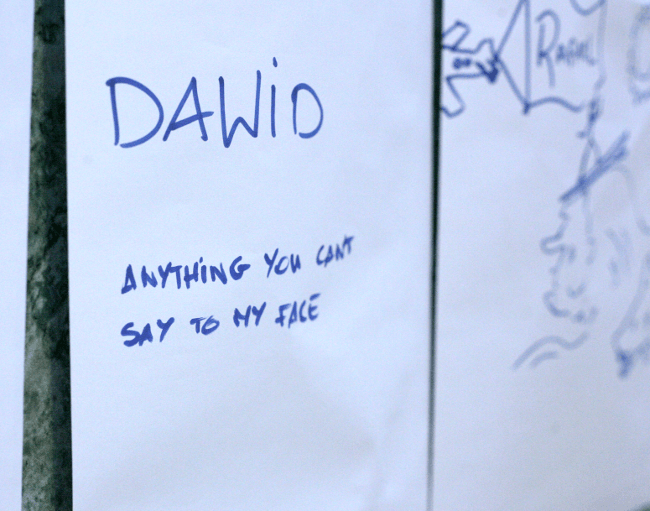Feedback Week
Our organization would benefit if people shared more feedback with each other. In fact, I can hardly think of any company where sufficient peer to peer feedback isn’t an issue. On that account Lunar isn’t any different even though we treat transparency really seriously. We would appreciate more peer to peer feedback on a regular basis.
At the same time sharing feedback isn’t an easy task. Frequently it requires us to move out of our comfort zones. In the end, we just don’t do that.
 Our solution for that was the feedback week. It is a very simple, safe to fail experiment. Anyone who wishes to participate tapes an envelope with their name on it to a wall in the common space and everyone else is invited to write down feedback for that person and put that in the same envelope.
Our solution for that was the feedback week. It is a very simple, safe to fail experiment. Anyone who wishes to participate tapes an envelope with their name on it to a wall in the common space and everyone else is invited to write down feedback for that person and put that in the same envelope.
To make it a really safe to fail experiment there are a couple additional constraints needed. In our case the whole thing was completely opt-in. If you didn’t require feedback no one forced you to participate. Also, only positive and supportive feedback was allowed.
That’s it. Told you. It’s simple.
Oh, and it lasted a little bit more than a week, that’s why we called it the feedback week.
Now, before I’d go further there was obviously a hypothesis behind the experiment. I assumed that if we provided an environment where we don’t force people to move out of their comfort zones they would share something new with others. At the same time as long as anyone put a single piece of paper in a single envelope I’d assume that it provided value in terms of generating more peer to peer feedback at Lunar.
One could question the rule about only positive feedback being allowed. One view on the usefulness of feedback is that it’s easier to build on ones own strengths than addressing weaknesses. From that perspective supportive feedback bears more value than critical information.
Personally, I don’t subscribe to that view. At least not as a general rule. I, for one, learn much more effectively from critical feedback. I do understand though that people have different learning patterns and for many supportive feedback is exactly what they need. For the rest, if not anything else, it feels good to hear good stuff about ourselves so there’s no potential downside really.
Another thing was that making the experiment safe was more important for me than maximizing feedback it produced. After all, we played with people’s behaviors and organizational culture. There’s no fallback strategy for such stuff.
Anyway, you want to like the results, right?
Almost everyone participated in the experiment. That validated the assumption that we strive to be getting more feedback. Then, talking about the volume of feedback, we could base it on the number of notes put inside the envelopes. There were a lot of them. It wasn’t just one here and there. People really did their homework and shared. A lot. (By the way, you guys are awesome! Thank you!)
Did it work?
Sure, it did. This isn’t the best part though. What I quickly realized was that many of us just used the feedback week as a catalyst to do the ultimate thing: go and share feedback face to face. One thing was that if someone wanted to go with something critical, well, the envelopes wouldn’t work because of the rules. Another thing was that some of us realized that they don’t need this artificial mechanism and they feel comfortable enough to share feedback the way it is supposed to be shared.
This was the real magic of the feedback week. It didn’t merely act as a one time event. It influenced our behaviors. And again, not only for a short while but in the long run. After all, once you learned that sharing feedback isn’t really as scary as you thought and people react to that really well, you will be much more likely do that again.
Oh, and by the way, many envelopes are still taped to the wall even though the feedback week is done. What’s more, since we are done with the experiment everyone sets their own rules, like “here goes everything that you can’t tell me face to face.”
 The best part about that tool is that it is applicable in pretty much any context. You can do that company-wide, but also in the context of a team or even individually. In fact, it would even work in a low trust environment. Of course results wouldn’t be nearly as good as in our case but you’d still get decent outcomes.
The best part about that tool is that it is applicable in pretty much any context. You can do that company-wide, but also in the context of a team or even individually. In fact, it would even work in a low trust environment. Of course results wouldn’t be nearly as good as in our case but you’d still get decent outcomes.
Even though I’ve pulled down my envelope I know there will be time when I’ll put it back for a while. I will be doing that till everyone feels comfortable sharing any crazy feedback they might have. It won’t happen overnight. In fact if it ever happens it would blow my head out.
